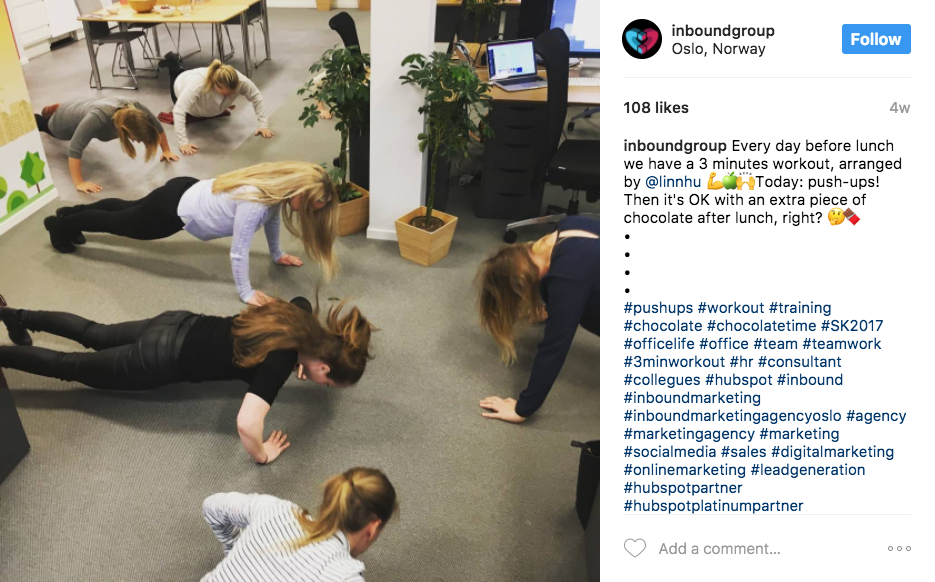Company culture can make or break a business.
Have you ever worked a gig where you just hated it—perhaps counted down every minute until it was time to go home?
I’m willing to bet that you could have cared less about the fate of the company so long as the paychecks kept rolling in.
Now, imagine yourself running a company chock full of aforementioned employees...it would unequivocally hinder the business as a whole, and even worse, taint the reputation of the company.
Company culture can make or break a business.
Instead of letting your company’s people become akin to the cast of the film Office Space, it’s important to build and cultivate a positive and healthy company culture that inwardly and outwardly projects an authentic impression.

So...what is it?
Company, organizational, or corporate culture—all overlapping concepts—is conceived of the values, attitudes, standards, and beliefs shared by the members of an organization.
It also encompasses the organization’s goals, structure, strategies, ethics, and public image. Definitions vary and the concept is quite abstract by nature, so let us further unravel this idea to clarify.
From the employees’ point of view, company culture breaks down into three factors: how challenging their role is, how much they like their coworkers, and the overall atmosphere in the work environment.
For employers, culture is derived from their vision, which condenses into the mission and values laid out by leadership that are easily digestible for everyone on board. It also entails actively cultivating the culture—or pivoting if it starts to sour.
While company culture sounds like one of those “nice to have” ideas, it’s truly a necessity: a healthy company culture increases engagement and enjoyment, retention, productivity, and even quality of work.
What’s not to love there?
To further sweeten the deal, consider how simple it is to build a positive culture: as Kip Tindell, Chairman of The Container Store puts it, “you can build a much more wonderful company on love than you can on fear.” As that one old saying goes, it takes less effort to smile than to frown...
In fact, many top employers try out different strategies to improve their company culture, for they truly believe that it is the best way to retain top talent. A great company culture not only attracts the best talent but also makes sure that those valued individuals stay with the company forever.
Such is the case with attracting and retaining customers for the long term, too. A great company culture automatically results in a great customer experience, and a great experience eventually inspires your best customers to market your brand, essentially becoming your best brand advocates.
How-to-Culture: Things to Consider
First and foremost, strict hierarchy and a great company culture are not usually compatible. The highest-ups usually know what’s best, but not always—opening communication both ways helps to fill in the cracks that may otherwise be overlooked.
Feedback, from employee to employee, employer to employee, or even employee to employer, is necessary for cohesive growth and efficiency.
Do away with a rigid hierarchy and give your employees autonomy, and you’ll be amazed at the difference: autonomy requires trust, trust implies respect, and respect fuels zeal.
Strict hierarchy and a great company culture are not usually compatible.
Every “top dog” in an organization—founder, president, CEO, etc.—has a vision for the company. To build a solid culture on that vision means to make sure that all employees share the vision and are driven by it to succeed. With vision, as with other elements that dictate company culture, the leadership must be an outstanding role model to guide the way.
A similar element to consider is what has been drilled into us from day one of preschool: the Golden Rule. Don’t be like Lumbergh, the loathed boss from Office Space—treat employees equally and with respect.
The easiest way to disengage employees is by displaying favoritism, so instead, be a fair employer who rightfully rewards hard work—and does not punish superfluously.
Autonomy requires trust, trust implies respect, and respect fuels zeal.
Culture is a living thing—literally, in biological terms—that needs to be guided and influenced. Therefore, hiring people to fit the culture is as important as the skills that the candidates can contribute.
By putting forth the values and beliefs of your company, it naturally attracts candidates who want to work for your company due to alignment of those values and beliefs, not just because of the pay rate.
Finally, having a bad company culture isn’t the end of the world; it’s the beginning of a strategic shift. Culture is alive and fluctuating, but it needs guidance to go in the right direction.
If the culture of your company needs help, it’s up to leadership to make the shift and let the effects trickle down.
Although difficult, shifting to a more positive company culture may take some sacrifices: if an employee is very disengaged and is spreading a toxic attitude that may hinder the company’s success, it may be time to let that one go. You want a hardworking team—in the truest sense of working together—that truly cares about moving the company forward.
Having a bad company culture isn’t the end of the world; it’s the beginning of a strategic shift.
Cultivating an Awesome Company Culture on a Budget
Herosmyth is a small-sized company—with small flexibility in our budget for company fun. But, it doesn’t stop us from building a great company culture; it just means getting more creative and less fancy.
There are many things, both big and small, that can make employees feel special and integral to the team and can be accomplished on a tight budget.
Celebrate the big and little things
One easy way to start is by celebrating things worthy of celebrating—simple as that. For instance, my first day at Herosmyth, I was greeted with a “welcome Zofia” sign on my monitor and a bunch of kisses—Hershey’s, that is. There was also an announcement post on social media that welcomed me to the family, not just the company.
Though there was no fanfare and exploding confetti balloons, simply acknowledging my first day and warmly welcoming me with the right language certainly made me feel special—and excited to get to work!
We take birthdays very seriously around here, too: showing up early to set up, printing embarrassing photos with a birthday message, some kind of baked goods...the works.
It doesn’t take much money to print a card or bake some cupcakes, but who doesn’t like to be acknowledged as the star on their birthday? The Herosmyth calendar has every person’s birthday accounted for, which shows that we, as a company, care about each individual’s birthday, and that we care about our team’s happiness.
Optimize the workspace
Consider the workplace layout: cubicles or sectioned-off offices tend to minimize communication and physically obstruct ease of communication. Working in an open space with team members near each other, or at least setting up an effective communication channel that’s simple to use, is an easy, low-budget alternative to scheduling routine work retreats that force the team to finally talk.
At Herosmyth, all of us cram (just kidding, it’s more spacious than it looks) into a single room. This means that organizing team meetings is as easy as asking, “can we all talk for a minute?” and turning around to face each other.
Things around here get done a lot more efficiently than would otherwise be possible without communicating while working, and our workspace layout is what makes this possible.
Talk to each other
Start every work day with a team meeting, either per department, or for small businesses, with everyone in the company gathering ‘round.
Take the time to talk about what tasks everyone has to complete, any blockers or help they need from other team members, and other matters.
Not only does it allow open communication to increase efficiency, but it also makes every person feel vital to the success of the company—and employees who know they matter to the big picture tend to truly care about their role.
The Design Group at UCF takes communication to another level: the office has two jars—a “nice jar” and a “douchebag jar” in which employees can drop notes to each other, both positive and negative.
Though their office has about 12 people, this concept could be scaled for almost any size company short of having an involved HR department. Luckily, the negative jar is mostly full of jokes, but could serve as an efficient tool for weeding out issues and conflict nonetheless.
Caffeinate as a team
Okay, so maybe not everyone has a slight caffeine addiction...but we do here at Herosmyth.
Whenever someone from our team starts to burn out in the afternoon, rather than going to grab some coffee themselves, it’s the norm to be inclusive invite and everyone to join.
Sometimes, the employees at Herosmyth get rewarded with free coffee for hard work, too—and believe me when I say “great job” goes a long way when paired with a caramel macchiato.
The coffee itself is a mere five bucks, but the conversations and quality, not-work-centric time spent together to and from the coffee shop is invaluable.
It’s important to show your employees that there is room for fun and unwinding when the stress levels get high.
It’s important to show your employees that there is room for fun and unwinding when the stress levels get high.
Grab lunch together
On a similar note, Herosmyth has a company lunch once a week—that is, we go get (usually) Thai food together on Wednesdays. It’s another opportunity to bond and become tighter-knit. It’s also a perfect low-budget demonstration of employee appreciation!
Besides, think of all the holidays and historical instances of when people have come together, differences and all, over food (Thanksgiving, anyone?): breaking bread together breaks down barriers to communication and growth. Company lunch helps cultivate a positive company culture.
Breaking bread together breaks down barriers to communication and growth.
Prioritize health and happiness
Walking meetings are an excellent way to target both: you a chance to stretch your legs, get some sunshine on your face, and you also get a chance to truly listen to your employees—and show that you care.
One-on-one walking meetings are a great place to speak about anything and everything in a comfortable setting; it’s also a great opportunity to pull an outstanding team member aside and give them proper praise without disrupting the rest of the workplace’s concentration.
Another example of a team being healthy together is Inbound Group: they do a quick workout together before lunch, and everyone joins, no matter how good their form is! It’s a small gesture, but the Inbound Group's team does a great job of literally team-building muscle (get it?).

Last, but certainly not least...
Have a little fun
Around our coworking space, Herosmyth is infamous for one—okay, maybe two—things: playing Call of Duty...and website design services. What I’m trying to say is, we know how and when to have fun—and sometimes, productivity actually spikes after a good round of video gaming.
While employees are expected to show up on time and stay the whole day, it’s impossible to be 100% productive for every second of that time, so breaking up some of the work with games can help with focus and stress.
It also builds a company culture that’s less serious and uptight, which generally leads to a more comfortable and productive environment to work in.
How does your company create a positive culture? Share your favorite examples with us in the comments below!




